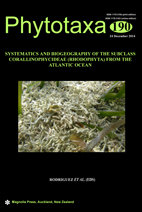Abstract
Hard bank rhodolith beds at 45–80 m depth offshore Louisiana in the Northwestern Gulf of Mexico harbor a diverse community of non-geniculate coralline algae spanning multiple lineages including both rhodolith-forming (biogenic) taxa and others encrusting autogenic rhodoliths. Identifying these members of the Corallinales to the correct genus and species is an ongoing process because many available names need to be validated by comparison to historical type specimens. A phylogenetic analysis of concatenated plastid (psbA), nuclear (LSU rDNA), and mitochondrial (COI) DNA sequences of non-geniculate corallines belonging to the subfamily Lithophylloideae (Corallinaceae), including newly generated sequences from recently collected specimens dredged at Ewing and Sackett Banks following the April 2010 Deepwater Horizon oil spill, reveals at least two distinct species of Lithophyllum sensu lato for the region. Scanning Electron Microscopy confirmed the presence of vegetative characters congruent with those for both Lithophyllum and Titanoderma. Lithophyllum is a newly reported genus for the northern Gulf of Mexico. The generic boundaries within the Lithophylloideae are addressed in light of possible evolutionary progenetic heterochrony that may have occurred within this subfamily.

